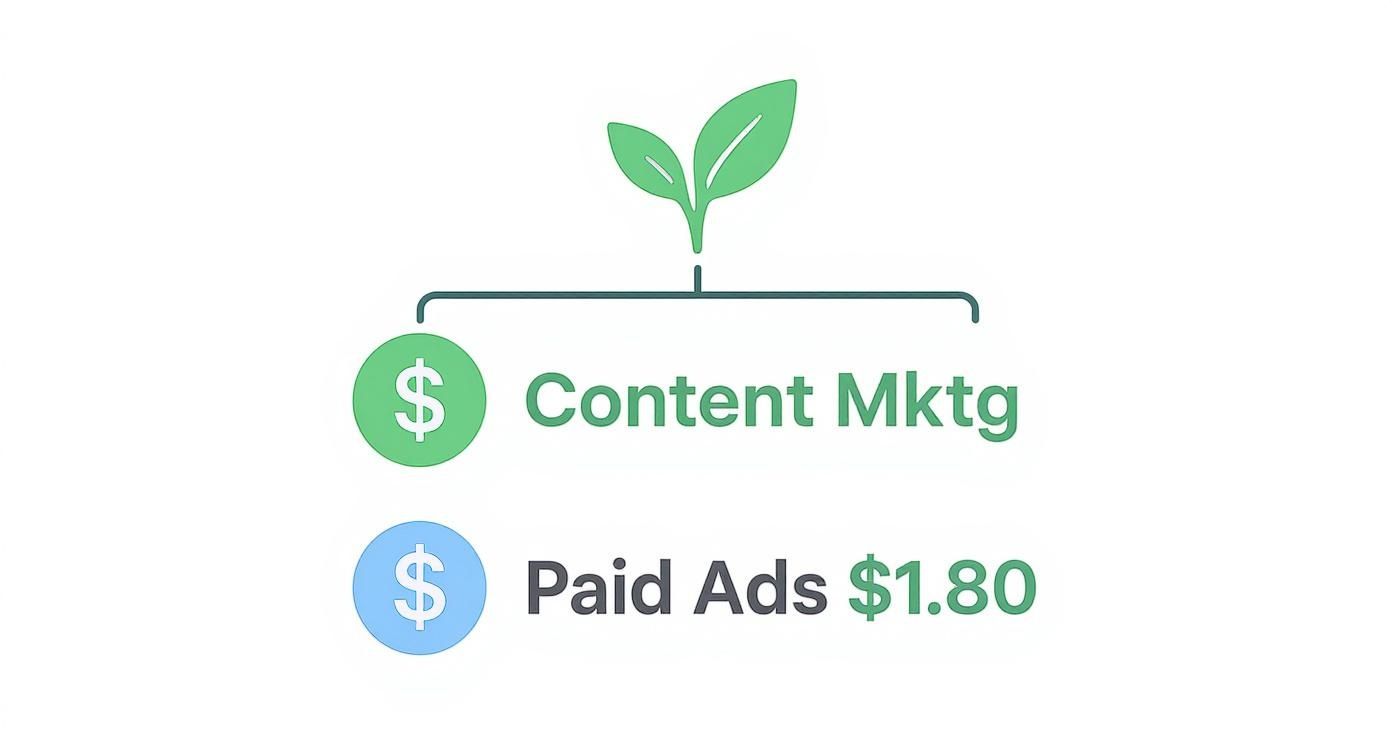Content marketing is the single most sustainable growth engine for a startup. It’s how you build real authority and generate qualified leads without getting stuck on the expensive treadmill of paid ads.
The whole idea is to create genuinely valuable and relevant content that pulls in your ideal customer. You're essentially turning your team's expertise into a marketing asset that keeps paying dividends long after you hit publish.
Why Your Startup Needs Content Marketing Right Now
Let's be real—as a founder, your budget is tight. Every single dollar has to count. It's tempting to throw that money at paid ads for a quick hit of traffic, but that creates a dangerous dependency. The moment you turn off the spend, the leads dry up.
Content marketing offers a totally different, more resilient path.
Instead of just renting an audience, you're building one you actually own. Every blog post, case study, or tutorial you create is an asset that works for you 24/7. It's out there attracting organic traffic, building trust, and educating potential customers while you sleep.
Build Authority and Trust in a Crowded Market
New startups have a massive credibility gap. Why should anyone trust your unproven solution over an established player?
Content is the answer.
By consistently sharing useful insights that solve your audience’s real problems, you prove you know what you're talking about. You stop being just another vendor and start becoming a trusted advisor. This is a game-changer for complex B2B products where education is a huge part of the sales cycle.
(We actually break down these strategies in our guide on content marketing for B2B.)
Building this kind of authority is a competitive moat that money can't just buy.
Achieve a Higher Return on Investment
Sure, content takes an upfront investment of time and resources. But the financial returns are hard to ignore.
Data shows content marketing can generate around $3 in revenue for every $1 invested. Compare that to paid advertising, which typically brings in about $1.80. That 67% higher ROI makes content a much smarter bet for a lean startup trying to make every dollar stretch.
The real job of startup content isn't just to get clicks. It's to build a foundation of trust. Every article you publish is another brick in that foundation, making your brand stronger and more resilient over time.
To get this right from the start, many startups bring in specialized SEO Content Marketing Services. It’s a smart move to make sure every piece of content isn't just valuable for the reader, but is also built to rank and drive sustainable traffic, maximizing your investment from day one.
Building Your Content Foundation From Scratch
Before you write a single blog post, you need a blueprint. A solid foundation is what separates content that actually drives growth from the stuff that just gets lost online. This is about moving beyond generic "know your audience" advice and digging into what makes your specific customers tick.
Without this groundwork, you're just guessing. You’ll churn out content that might look good but fails to connect with the people who actually need your product. Startups don't have the time or money to waste on content that misses the mark.
Define Your Ideal Customer Profile
When you're just starting, you probably don't have mountains of customer data. That's okay. You can get surprisingly sharp insights just by being resourceful.
Instead of guessing, try these practical methods to build your first customer profile:
- Analyze Competitor Reviews: Scour sites like G2, Capterra, or even Reddit threads for reviews of your competitors. Look for the exact words people use to describe their problems and what they loved (or hated) about the solution. This is unfiltered, raw feedback.
- Run a Quick Survey: Send a simple five-question survey to your first handful of users or email subscribers. Ask them about their biggest challenges, what other tools they use, and what success really looks like for them.
- Interview Your First Believers: Hop on a 15-minute chat with your earliest customers. These conversations are absolute goldmines for understanding their pain points and the "aha" moment that made them choose you over everyone else.
Set Goals That Actually Matter
Vague goals like "increase brand awareness" are useless for a startup. You need objectives tied directly to business outcomes. A strong content goal is specific, measurable, and has a deadline.
Here’s the difference:
- Weak Goal: "Get more traffic to our blog."
- Strong Startup Goal: "Increase qualified demo requests from organic search by 20% in Q3."
This level of clarity forces you to prioritize content that directly supports growth. It turns your content from a cost center into a predictable revenue driver.
A solid strategy starts with identifying the core themes that will guide everything you create. This is often called defining your content pillars. For a complete walkthrough on how to connect these pillars to your goals, you can explore our detailed content marketing strategy framework.
This hierarchy diagram shows just how much more ROI startups can get from content marketing compared to paid ads.

The visualization makes it clear: for every dollar you put in, content marketing generates a significantly higher return. That makes it a much more capital-efficient way to grow.
Despite these clear benefits, tons of companies still stumble on the basics. Research shows that while 80% of the most successful companies have a documented content marketing strategy, common hurdles still trip people up, like a lack of clear goals (42%) and ineffective audience research (29%).
Your startup's brand voice is how you sound inside your customer's head. It's the personality behind your words—are you a helpful expert, a witty friend, or a straightforward mentor? Pick a voice that resonates with your ideal customer and stick with it everywhere.
The Startup Content-to-Funnel Mapping Framework
Once you have your foundation, the next step is to align your content with your customer's journey. Creating random blog posts won't work. You need to create specific assets designed to move a potential customer from one stage to the next.
This framework helps you map content formats directly to what your customer is trying to achieve at each step.
By using this map, you ensure every piece of content you create has a clear purpose. You're not just publishing articles; you're building a system that guides prospects toward becoming loyal customers.
Creating Content That Actually Gets Noticed
Alright, you've got your foundation. Now for the fun part: creating content that builds real authority and actually gets people to do something.
For a startup, this isn't about cranking out a blog post every day. It's about making every single thing you publish work its tail off. The goal is to create smarter, not just more.

Embrace the Pillar and Cluster Model
The smartest approach I've seen is building around a "pillar" article—a massive, exhaustive guide on a core topic your audience is desperate to understand. This piece needs to be so good that it becomes the definitive resource.
From there, you strategically slice and dice that pillar into dozens of smaller "cluster" assets. This move multiplies the value of your initial effort and gets your message out across different platforms where your audience actually lives.
This isn't just about efficiency; it builds serious topical authority with search engines. For some more concrete examples, check out our guide packed with fresh content creation ideas you can adapt.
High-Impact Content Formats for Startups
Not all content is created equal, especially when you're running lean. You have to focus on formats that solve specific problems and are ridiculously easy to share.
The data backs this up. A whopping 83% of global consumers want to see more video. Infographics can boost website traffic by up to 12% and are 30 times more likely to be read than a wall of text. At the same time, people still crave depth—the average blog post is now 1,427 words long. You can find more data like this in these content marketing statistics.
Here are a few formats that punch way above their weight:
- Problem-Solving Video Tutorials: You don't need a film crew. Grab a simple tool like Loom or Canva and record your screen as you walk someone through solving one specific, painful problem. These are pure gold.
- Simple, Shareable Infographics: Turn the key stats or a complex process from your pillar article into a clean infographic using Canva. They're perfect for social media and are absolute magnets for backlinks.
- Data-Driven Blog Posts: If you have any unique data—even from a small customer survey—it's a content goldmine. Original data gets you links and instantly positions you as an authority.
The goal is to own a conversation, not just chime in. A powerful pillar article becomes your brand's definitive statement on a topic, attracting links, traffic, and trust long after you hit publish.
The Power of Repurposing
Once that pillar article is live, the real work begins. Don't just let it sit there. Your repurposing strategy is what turns one big effort into a month's worth of marketing.
Think about how one 3,000-word guide can be transformed:
- Short-Form Videos: Each key section becomes a 60-second video for TikTok or YouTube Shorts.
- LinkedIn Carousel: The main takeaways get turned into a slick, swipeable carousel post.
- Email Mini-Course: Break the guide into a five-day email course to nurture new subscribers.
- Twitter Thread: Summarize the core arguments and data points into a compelling thread.
- Guest Post Angle: Pull out one unique statistic and use it as a hook to pitch a guest post to an industry blog.
This is how you reach different people on the platforms they prefer, all while driving them back to your core pillar piece and cementing your authority.
Getting Your Content in Front of the Right People
Look, creating brilliant content is only half the job. If nobody sees it, all that work was for nothing. This is the distribution phase, and for a startup, it has to be scrappy, smart, and deliver a serious return on your time.
You don't need a massive ad budget to build an audience from scratch. You just need to show up where your ideal customers are already hanging out and learn how to talk to them like a human.

Find and Engage Niche Online Communities
Your future customers are already talking. They’re in niche subreddits, private Slack groups, and old-school industry forums. Your job is to find these digital water coolers and become a helpful member of the community—not a drive-by spammer.
The key here is to lead with value, not a link. Spend real time there. Answer questions, offer genuine advice, and share what you know without asking for anything in return.
Once you’ve built a reputation as someone who knows their stuff, then you can start sharing your own content where it’s actually relevant. For example, if someone in a SaaS founder's Slack group asks for advice on reducing churn, and you just published a deep-dive on that exact topic, sharing it is a helpful act, not self-promotion.
Becoming a trusted voice in a niche community is one of the highest-leverage things a startup founder can do. You get raw feedback, build real relationships, and earn the right to share your work with a hyper-relevant audience.
Secure Guest Posts on Industry Blogs
Guest posting is a classic for a reason: it flat-out works. For startups, it’s a triple threat that accomplishes three critical goals at once:
- Builds Authority: Getting published on a respected industry site gives you instant credibility.
- Earns Backlinks: These links are SEO gold. They tell search engines your site is a trustworthy resource.
- Taps Into an Existing Audience: You get to put your best ideas in front of a pre-built, relevant readership.
Start by making a list of blogs your ideal customers actually read. Don't just chase the biggest names; smaller, hyper-focused blogs can often drive way more qualified traffic. Then, craft a personalized pitch that proves you've done your homework, understand their audience, and have a genuinely unique idea to share.
Amplify Your Best Content with a Small Budget
Even a tiny ad spend can make a huge impact if you’re smart about it. The trick is to stop promoting every single article you publish.
Instead, put your budget behind your proven winners—the articles that are already getting some organic love or have a high conversion rate for a key action, like signing up for a demo.
Platforms like LinkedIn or Twitter let you target users with surgical precision based on job titles, company size, and interests. A $50 or $100 boost on a pillar post targeting your exact customer profile can drive hundreds of highly relevant readers to your site.
This simple shift turns content from a hopeful shot in the dark into a predictable machine for generating traffic and leads.
Turning Content Performance into Startup Growth
You’ve invested your most precious resource—time—into creating content. Now comes the hard part: making sure that investment actually pays off.
This is where a lot of startups get lost. They start chasing vanity metrics like page views or social media likes. Those numbers feel good, but they don't actually move the needle on growth.
To build a real content engine, you have to get ruthless about tracking what matters. Forget the noise and focus on the metrics that tie directly to business outcomes. That's how you survive and scale.
From Data Points to Business Decisions
The goal isn't just to collect data; it's to turn that data into your next strategic move. You don't need a complicated, expensive analytics stack to do this.
Honestly, the free tools are more than enough. Google Analytics and Google Search Console are all a startup really needs to get started. Don't overcomplicate it.
Instead of some sprawling dashboard with dozens of charts, build a simple view. Track the handful of metrics that have a real impact on your bottom line. This creates a powerful feedback loop: you publish, you measure, you learn, and then you invest your limited resources with way more confidence.
Your content analytics should tell a story about what your audience truly cares about. Every click, every download, every demo request is a vote for a specific topic or format, guiding you on what to create next.
Key Performance Indicators That Matter for a Startup
To keep your content marketing for startup efforts laser-focused, you need to track specific, high-impact KPIs. These are the metrics that bridge the gap between a blog post and actual revenue.
Here’s what I’d recommend focusing on:
Qualified Leads from Content: How many people read a specific blog post and then signed up for a demo? Or downloaded a gated resource? This is your content’s most direct contribution to the sales pipeline.
Organic Sign-up Conversion Rate: Look at all the visitors who land on your content from search engines. What percentage of them takes a key action, like starting a free trial? This tells you if your content is attracting the right kind of audience—people with real intent.
Content's Impact on Customer Acquisition Cost (CAC): Track how your organic traffic influences your overall CAC. As your content efforts scale and bring in more "free" leads from search, you should see your blended CAC start to trend downward over time. It’s a slow burn, but a powerful indicator.
This approach transforms your analytics from a passive report card into an active playbook for growth. You’ll stop guessing what to write and start making data-informed decisions that build real momentum.
By focusing on what resonates and converts, you ensure every piece of content works as hard as you do.
Common Questions About Startup Content Marketing
Diving into content marketing can feel like a leap of faith, especially when you're a founder wearing ten different hats. Most startups grapple with the same handful of questions right out of the gate.
Let's clear them up.
How Much Should a Startup Spend on Content Marketing?
There’s no magic formula here, but a good starting point for early-stage startups is putting 20-30% of the total marketing budget toward content.
But let’s be real: your biggest investment at the beginning won’t be cash. It’s going to be your time.
Forget spreading a tiny budget across ten mediocre blog posts. Instead, focus your energy on creating one or two truly exceptional, foundational pieces. A single, definitive guide that solves a painful problem for your ideal customer is worth far more than a flurry of forgettable content.
Once you see that piece gaining traction, you can reinvest the returns to scale up.
How Long Until We See Results from Content Marketing?
Patience isn't just a virtue in content marketing; it's a requirement. This is a long game, not a quick-win channel. Generally, you’ll need to wait six to nine months before seeing significant, measurable results like a steady stream of organic traffic and qualified leads.
That doesn't mean you'll be flying blind for half a year. You'll see promising signs much earlier.
Keep an eye out for these leading indicators in the first few months:
- Keywords starting to show up on the second or third page of Google.
- A noticeable uptick in direct traffic and people searching for your brand name.
- Real engagement (comments, shares) on the few articles you've published.
These small wins are proof that you're on the right path.
What’s More Important: SEO or Great Writing?
This is a trick question. It's like asking if an engine is more important than wheels—you're going nowhere without both.
SEO without great writing gets you robotic, unhelpful content that might rank for a minute but will never convert anyone. Great writing without SEO means your brilliant insights will be buried on page ten of Google, where no one will ever find them.
Think of it this way: SEO gets people to your front door. Great writing invites them inside and makes them want to stay.
The goal is to seamlessly weave keywords and search intent into a story that is genuinely useful and compelling. The best content marketing for startup success happens when the technical side of SEO and the human element of great storytelling work in perfect harmony.
At PimpMySaaS, we help B2B SaaS companies get noticed by becoming the go-to answer on platforms where your future customers are asking questions. Learn how we can build your authority and drive growth. Find out more at https://www.pimpmysaas.com.
